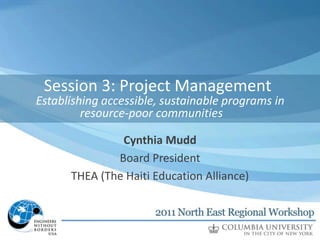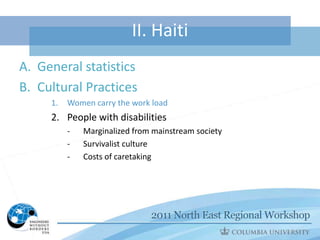THEA talk at EWB Conference 11-19-11
- 1. Session 3: of Presentation Title Project Management Establishing accessible, sustainable programs in Secondary title (if applicable) resource-poor communities Name Cynthia Mudd Position Board President Organization THEA (The Haiti Education Alliance)
- 2. I. Introduction A. Occupational Therapist Information 1. Assess each persons abilities and disabilities in these areas of function: - Physical - Cognitive - Psycho-social - Roles in family and community
- 3. A. Occupational Therapy Information 2. Determine next step toward increased function (just right challenge) 3. Environmental Modifications - keep simple and easy to use - need on-going assessment as function changes over time
- 5. I. Introduction A. Occupational Therapist Information B. THEA (The Haiti Education Alliance) Facilitating long term sustainable solutions one community at a time
- 6. I. Introduction A. Occupational Therapist Information B. THEA (The Haiti Education Alliance) Facilitating long term sustainable solutions one community at a time Mission: To provide education opportunities to impoverished children and adults in Haiti empowering them to strengthen their communities and emerge to a life of healing and hope.
- 17. I. Introduction A. Occupational Therapist Information B. THEA C. World Report on Disability
- 18. I. Introduction A. Occupational Therapist Information B. THEA C. World Report on Disability Six areas of focus: 1. General Healthcare 2. Rehabilitation 3. Assistance & Support 4. Enabling environments 5. Education 6. Work and Employment
- 19. II. Haiti A. General statistics 1. Population ~9.8 mil - Estimated 800,000 people had a disability before earthquake -Additional 450,000 after earthquake
- 20. II. Haiti A. General statistics 1. Population ~9.8 mil 2. Education
- 21. II. Haiti A. General statistics 1. Population ~9.8 mil 2. Education • ~ 1.3 million children do not have access • primary school enrollment ~65%; only 35% graduate • secondary school enrollment ~20%; only 6% graduate • 60% of Haitian teachers are qualified to teach • 52.9 literacy rate
- 22. II. Haiti A. General statistics 1. Population ~9.8 mil 2. Education 3. Health Care • 40% do not have access
- 23. II. Haiti A. General statistics B. Cultural Practices 1. Women carry the work load - Higher incidence of disability - Higher incidence of birth defects and developmental disabilities in their children - Occupational hazards (i.e. pulmonary illnesses, burns, sexual assault of women and children gathering water and sticks, etc.) - Solar cook stoves?
- 30. II. Haiti A. General statistics B. Cultural Practices 1. Women carry the work load 2. People with disabilities - Marginalized from mainstream society - Survivalist culture - Costs of caretaking
- 32. II. Haiti A. General statistics B. Cultural Practices 1. Women carry the work load 2. People with disabilities 3. Voodou - a cultural and religious practice for healing in absence of access to adequate medical care
- 33. II. Haiti A. General statistics B. Cultural Practices 1. Women carry the work load 2. People with disabilities 3. Voodou 4. Interpersonal/Communication
- 34. III. Meeting Un-met Needs A. Universal Design 1. Definition - Universal Design is committed to ensuring that all spaces, products, and communications meet the needs of people of all ages and various levels of ability. - Universal Design strives to achieve safety, comfort, and convenience for all citizens in the community.
- 35. III. Meeting Un-met Needs A. Universal Design 1. Definition 2. Enables individual and social participation
- 36. III. Meeting Un-met Needs A. Universal Design 1. Definition 2. Enables individual and social participation 3. Applications to physical environments • Wells/pumps; buildings; community events
- 37. III. Meeting Un-met Needs A. Universal Design 1. Definition 2. Enables individual and social participation 3. Applications to physical environments 4. Applications to educational/intellectual environments • Who will benefit? • How will they benefit? • Teaching project maintenance
- 39. III. Meeting Un-met Needs A. Universal Design 1. Definition 2. Enables individual and social participation 3. Applications to physical environments 4. Applications to educational/intellectual environments *Evidence-based
- 40. III. Meeting Un-met Needs *Evidence-based: • Maximize all student’s potential/meeting environmental needs • Type of classroom is less important than quality • Inclusion has no negative impact on children without disabilities • Multiple means of expression, representation, and engagement
- 44. III. Meeting Un-met Needs *Evidence-based: • Develop guidelines to monitor progress • Focus on education results, not access • High standards and more means • Variability is good for everyone
- 45. III. Meeting Un-met Needs A. Universal Design 1. Definition 2. Enables individual and social participation 3. Applications to physical environments 4. Applications to educational/intellectual environments /*Evidence-based 5. Universal design at national level/Haiti – current initiatives for reconstruction a. In partnership with State Secretariat for the inclusion of Persons with Disabilities, an Advocacy program in March 2010 to strengthen capacities of local DPO’s
- 46. III. Meeting Un-met Needs A. Universal Design 1. Definition 2. Enables individual and social participation 3. Applications to physical environments 4. Applications to educational/intellectual environments 5. Universal design at national level/Haiti – current initiatives for reconstruction a. In partnership with State Secretariat/Persons with Disabilities b. Toolkit for Long-term Recovery “Haiti: Reconstruction for all” - Global Partnership for Disability and Development in 2010
- 47. III. Meeting Un-met Needs A. Universal Design B. World Vision – Hierarchical Five Fingers of Development 1. Clean Water 2. Food Supply 3. Education 4. Medicine 5. Economic Development
- 48. III. Meeting Un-met Needs A. Universal Design B. World Vision C. Increase access to Clean Water & Nutrition 1. Access to wells/water - long, angled pump handles for various heights and strengths - ramps and areas for sitting
- 52. Q-DRUM
- 53. III. Meeting Un-met Needs A. Universal Design B. World Vision C. Increase access to Clean Water & Nutrition 1. Access to clean water 2. Access to nutrition - Backyard gardening - Drip irrigation for year-round nutrition
- 54. III. Meeting Un-met Needs A. Universal Design B. World Vision C. Increase access to Clean Water & Nutrition 1. Access to wells/water 2. Access to nutrition 3. Pay with food
- 55. III. Meeting Un-met Needs A. Universal Design B. World Vision- 5 fingers of development C. Increase access to Clean Water & Nutrition D. Increase access to Education 1. Make school and municipal buildings accessible
- 57. III. Meeting Un-met Needs A. Universal Design B. World Vision C. Increase access to Clean Water & Nutrition D. Increase access to Education 1. Make school and municipal buildings accessible 2. Dormitories for secondary students
- 58. III. Meeting Un-met Needs A. Universal Design B. World Vision C. Increase access to Clean Water & Nutrition D. Increase access to Education 1. Make school and municipal buildings accessible 2. Dormitories for secondary students 3. Oral tradition/Lack of teaching resources and qualified teachers
- 60. III. Meeting Un-met Needs A. Universal Design B. World Vision C. Increase access to Clean Water & Nutrition D. Increase access to Education 1. Make school and municipal buildings accessible 2. Dormitories for secondary students 3. Oral tradition/Lack of teaching resources and qualified teachers 4. Funding Needs
- 61. III. Meeting Un-met Needs A. Universal Design B. World Vision C. Increase access to Clean Water & Nutrition D. Increase access to Education E. Increase access to Health Care 1. Hospitals/Clinics – Qualified Professionals?
- 62. III. Meeting Un-met Needs A. Universal Design B. World Vision C. Increase access to Clean Water & Nutrition D. Increase access to Education E. Increase access to Health Care 1. Hospitals/Clinics – Qualified Professionals? 2. Vocational training- RTTP, MEVP
- 63. III. Meeting Un-met Needs A. Universal Design B. World Vision C. Increase access to Clean Water & Nutrition D. Increase access to Education E. Increase access to Health Care 1. Hospitals/Clinics – Qualified Professionals? 2. Vocational Training- RTTP, MEVP 3. Community Health & Rehabilitation Workers
- 64. III. Meeting Un-met Needs A. Universal Design B. World Vision C. Increase access to Clean Water & Nutrition D. Increase access to Education E. Increase access to Health Care 1. Hospitals/Clinics – Qualified Professionals? 2. Vocational Training- RTTP, MEVP 3. Community Health & Rehabilitation Workers 4. Community health care technology for data collection
- 65. III. Meeting Un-met Needs A. Universal Design B. World Vision C. Increase access to Clean Water & Nutrition D. Increase access to Education E. Increase access to Health Care 1. Hospitals/Clinics – Qualified Professionals? 2. Vocational Training- RTTP, MEVP 3. Community Based Health & Rehabilitation 4. Community health care technology for data collection 5. International classification of function (ICF) • assessment tool, increased quantity & quality of data/statistics, etc…
- 66. III. Meeting Un-met Needs E. Increase access to Health Care 1. Hospitals/Clinics – Qualified Professionals? 2. Vocational Training- RTTP, MEVP 3. Community Based Health & Rehabilitation 4. Community health care technology for data collection 5. International classification of function (ICF) - assessment tool, increased quantity & quality of data/statistics, etc… 6. Increased research stems increased funding, influences national policy, and improves standards for improved healthcare in the country
- 67. IV. Conclusion A. Wrap-Up of Ideas - What happens when we leave? - In creating self-sustaining communities we may need to provide resources they don’t have (i.e. wells, training, assessment tools, etc.). - Consider the personal/ social/relational components of projects
- 68. IV. Conclusion A. Wrap-Up of Ideas -Collaboration -Education -Celebration
- 69. IV. Conclusion A. Wrap-Up of Ideas -Collaboration -Education -Celebration B. References and handouts available
- 70. V. Questions and Ideas ?????
- 72. References 1. World Report on Disability- WHO and World Bank 2. No Nonsense Guide to International Development- Maggie Black 3. Five Fingers of Development- World Vision 4. Education in Haiti Statistics- Wikipedia 5. Seven Principles of Universal Design- http://www.udll.com/media- room/articles/the-seven-principles-of-universal-design/ - Action Magazine, December 2006; Rosemarie Rossetti 6. Q Drum (Pty) Ltd: The Rollable Water Container for Developing Countries http://www.qdrum.co.za/image-gallery - Troyeville, Johannesburg, South Africa 7. Inclusive Reconstruction: Haiti for All; Toolkit for Universal Design in Long-Term Recovery http://gpdd-archive.syr.edu/news/docs/Toolkit_on_Inclusive_Reconstruction Chapter_1_Physical_Environment.pdf - Global Partnership for Disability and Development










































































